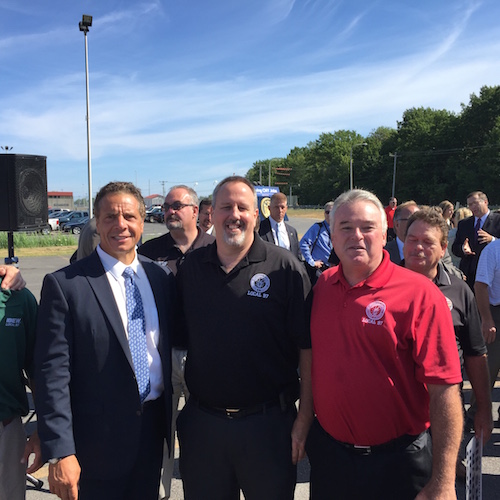Last year, New York’s James A.
FitzPatrick nuclear plant was slated to close. Now, it’s
hiring,
and it’s thanks to IBEW members and their work with partners from the municipal
level to the governor’s office.

|
| Syracuse, N.Y., Local 97 members worked with everyone from local leaders to Gov. Cuomo, pictured left, with Local 97 Business Manager Ted Skerpon, center, and Western Division Business Representative Phil Wilcox.
|
On Aug. 1, the New York Public Service Commission unanimously approved an order that will provide credits to the Empire State’s nuclear plants for their production of clean energy, making them more economically viable. Nuclear, in addition to being a reliable, baseload energy source, produces electricity with zero carbon emissions. The clean energy standard also requires 50 percent of New York's electricity to come from renewable sources like wind and solar by 2030.
The decision marks the first time in New York’s history that nuclear has been recognized as a clean energy source in its pricing, putting it on par with renewables. The decision also saved FitzPatrick and its upstate counterparts, R.E. Ginna and Nine Mile Points I and II, all located along Lake Ontario.
“In implementing the clean energy standard, the Cuomo administration has displayed its unwavering dedication to our environment, and our upstate region and its nuclear facilities,” said Ted Skerpon chairman of the IBEW Utility Labor Council of New York and Syracuse, N.Y., Local 97 business manager.
The labor council is comprised of 18 IBEW utility locals, representing over 15,000 members, and lobbies for laws and regulations related to utility workers in the state.
Fitzpatrick employs about 600 people, with approximately half represented by Local 97. The local also represents about 550 employees at Nine Mile Point, Skerpon said.
FitzPatrick is owned by Entergy Corp., which also owns the Indian Point plant located closer to New York City. Exelon Corp. owns the other upstate plants and offered to buy FitzPatrick – but only if the subsidy credits were approved, reported Oswego News, a local publication.
Saving Nuclear, Saving Upstate
Due to market forces that put nuclear at a disadvantage, as well as an abundance of cheaper natural gas, FitzPatrick wasn’t able to compete, making it a candidate for closing. The labor council, the Cuomo administration and others tried repeatedly to keep it open, but nothing worked.
But IBEW members lobbied the state Legislature and worked with everyone from local community groups to businesses and fellow labor organizations, forming a coalition, Upstate Energy Jobs. The New York State AFL-CIO also encouraged supporters to send comments to the commission through a link on their website.
The coalition circulated a petition in support of the plants that garnered more than 3,500 signatures. Local community leaders also sent a letter to the commission, reported Oswego News.
The labor council commissioned a report, released in December, to study the impact of the upstate plants on the economy as well as the environment. The report concluded that the plants avoid almost 16 million tons of carbon dioxide emissions annually and account for 61 percent of carbon-free generation in upstate New York. Renewable energy alone could not make up for their absence, it determined.
“If these plants close abruptly, they in all likelihood will be replaced by the attributes of expanded fossil fuel base generation,” said Public Service Commission Chair Audrey Zibelman. “This will impair our ability to achieve our environmental goals.”
As states struggle to meet the goals of the Environmental Protection Agency’s Clean Power Plan, keeping nuclear plants running is crucial. The CPP mandates that states reduce greenhouse gas emissions from power plants by 2030.
Additionally, the report found that the FitzPatrick, Ginna and Nine Mile Point plants account for nearly 25,000 full-time jobs, direct and secondary. Some of those are IBEW construction jobs when the plants temporarily close for refueling and maintenance. Depending on the size and length of the shut-down you could easily have 75 to 100 members being called up for work, from Syracuse Local 43 or Rochester Local 86, said Third District International Representative Dennis Affinati.
“This is a great win not just for our members, who finally get some job security back, but for the state of New York,” said Third District Vice President Don Siegel. “I couldn’t be prouder of our members who stood fast in their commitment to providing the state with clean energy and for working with the governor and others to create a common sense, environmentally sustainable policy.”
Photo credit: Entergy Nuclear via Nuclear
Regulatory Commission.